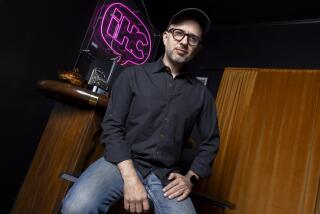Disabled-Rights Advocates Criticize Arts Plaza’s Wheelchair Access : Design: City staff members insist the new theater meets or surpasses all U.S. standards for accessibility.
- Share via
Blasting the Civic Arts Plaza as a death trap, two disabled-rights advocates presented Thousand Oaks leaders Tuesday with a list of alleged defects in the new auditorium.
John and Phyllis Ellis, who have long accused the city of ignoring disabled residents’ needs, said Thousand Oaks’ 1,800-seat main theater inadequately serves wheelchair-bound patrons.
From life-threatening exit routes that could be blocked in a power failure to annoying wheelchair seating shunted to the fringes of the auditorium, they cited questionable design features.
But city staff members repeated their position that the building meets or surpasses all federal standards for accessibility for the disabled.
And another disabled-rights activist praised the Civic Arts Plaza as safe, comfortable and welcoming.
“I’ve been in a lot of theaters, and this has more (amenities) than I’ve ever seen before,” said Mike Taylor, a member of the city’s disabled access appeals board.
Taylor, who uses a wheelchair, added: “To me, this is a wonderful convenience.”
To the Ellises, however, the theater is a virtual house of horrors.
As they toured the auditorium Tuesday--John Ellis snapping photos while his wife, Phyllis, maneuvered through the rows in her motorized wheelchair--they vowed to press for a federal investigation into the Civic Arts Plaza’s design.
No. 1 on their hit list: the small, black electric lift used to transport wheelchairs from one seating level to another.
Although the Civic Arts Plaza has a backup generator, the Ellises said they feared an earthquake or other disaster could knock out power for hours--shutting down the lift and stranding disabled patrons.
“There’s no way for people to get out,” John Ellis said.
In part because of that danger, the federal government plans to outlaw electric lifts in municipal buildings by modifying the Americans With Disabilities Act, according to Liz Savage, an expert on disabled-access standards who works in the attorney general’s office in Washington.
The lifts will be banned because they can break down or fail during power failures, Savage said. Lifts can also be inconvenient, and disabled people sometimes need help using them. “New construction is supposed to maximize independence” for disabled people, Savage explained, “and lifts don’t do that.”
But the new ban on electric lifts will not take effect for several months, she said. Even then it will apply only to new construction, so the Civic Arts Plaza can continue to use an electric lift.
Thousand Oaks’ director of building and safety, Barry Branagan, has defended the lift as state-of-the-art technology. In a total blackout, he said, frail and disabled audience members would simply have to rely on a helping hand from ushers.
He said multistory office buildings usually lack wheelchair ramps as well. If the elevators go on the fritz, disabled people must somehow make their way down the stairs. “Mostly what happens,” Branagan said, “is that people help other people.”
Backing the city’s decision to use a lift, Taylor said he found the mini-elevator a wonderful boon for wheelchair users. As he rattled up and down in the noisy lift, he marveled: “You’ve got plenty of room, everything is safe, you can’t get your wheels caught, and nothing feels flimsy.”
The disabled rights activists also clashed on the issue of wheelchair seating.
John and Phyllis Ellis complained that the theater reserves only aisle and back-row seating for wheelchairs--so disabled patrons cannot buy front-and-center seats. They also protested that the space allocated for wheelchairs is cramped.
But Taylor said he could enjoy the show from any vantage point in the theater. “How much more room do we need?” he asked, wheeling in and out of a third-row aisle seat. “You can’t expect to have everything.”
The disputes over the Civic Arts Plaza’s accessibility came during a two-hour workshop Tuesday morning, when Taylor and Phyllis Ellis taught the city’s 11 professional ushers how to help disabled visitors around the Civic Arts Plaza.
Among their tips: Look disabled patrons in the eyes and talk to them directly. Do not assume all wheelchair-bound people are deaf--address them in a normal tone of voice. If they shift into a regular auditorium seat for the show, stash their wheelchair nearby and assure them it will be readily accessible.
“If you express a look of confidence, helpfulness and understanding, that will go a long way,” Phyllis Ellis said.
Building and Safety Director Branagan offered his own advice for disabled patrons--ask for help.
“People who need special services need to alert us ahead of time so we can make arrangements to serve them,” Branagan said. “We’ll do anything anyone asks of us. That’s our commitment.”
More to Read
The biggest entertainment stories
Get our big stories about Hollywood, film, television, music, arts, culture and more right in your inbox as soon as they publish.
You may occasionally receive promotional content from the Los Angeles Times.










